Click on images to enlarge
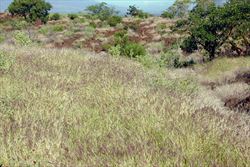
infestation (Photo: Forest and Kim Starr, USGS)
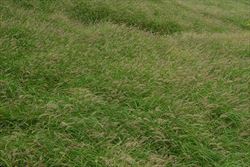
infestation (Photo: Forest and Kim Starr, USGS)
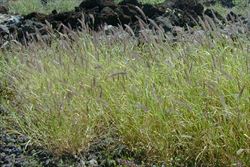
habit (Photo: Forest and Kim Starr, USGS)
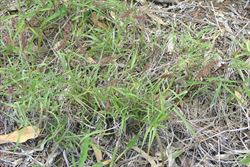
habit (Photo: Sheldon Navie)
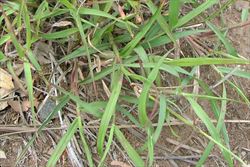
leaves (Photo: Sheldon Navie)

seed-heads (Photo: Sheldon Navie)
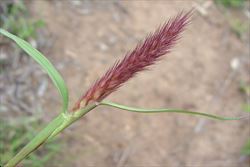
young seed-head (Photo: Sheldon Navie)
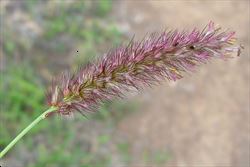
close-up of seed-head (Photo: Sheldon Navie)
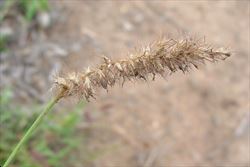
mature seed-head (Photo: Sheldon Navie)

close-up of seeds (Photo: Steve Hurst at USDA PLANTS Database)
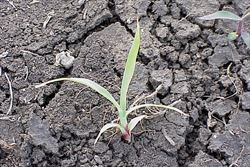
seedling (Photo: Sheldon Navie)
Scientific Name
Cenchrus ciliaris L.
Synonyms
Pennisetum ciliare (L.) Link
Cenchrus glaucus C.R. Mudaliar &
Sundararaj
Pennisetum cenchroides A.
Rich.
Pennisetum incomptum Nees ex
Steud.
Family
Gramineae (South Australia)Poaceae (Queensland, New South Wales, the ACT, Victoria, Tasmania, Western Australia and the Northern Territory)
Common Names
African foxtail, African foxtail grass, anjan grass, anjangrass, black buffel grass, blue buffalo grass, buffel grass, buffelgrass, foxtail buffalo grass
Origin
Native to large parts of Africa (i.e. Egypt, Libya, Ethiopia, Sudan, Kenya, Tanzania, Uganda, Ghana, Mali, Niger, Nigeria, Senegal, Angola, Mozambique, Zambia, Zimbabwe, Botswana, Namibia, South Africa and Swaziland), Sicily, the Arabian Peninsula (i.e. Saudi Arabia, Oman and Yemen), western Asia (i.e. Afghanistan, Iran, Iraq, Israel, Jordan and Syria) and the Indian sub-continent (i.e. India and Pakistan).
Cultivation
Buffel grass (Cenchrus ciliaris) is widely cultivated as a pasture grass and planted for erosion control, particularly in the semi-arid rangelands of northern Australia.
Naturalised Distribution
This species is widely naturalised throughout mainland Australia (i.e. throughout Queensland, New South Wales, Western Australia, South Australia and the Northern Territory). It is also naturalised on the Cocos Islands and on Ashmore Reef.
Naturalised overseas in southern USA, Mexico, Central America, South America and the Pacific (e.g. Hawaii).
Habitat
This species prefers sandy soils and is a weed of rangelands, grasslands, open woodlands, floodplains, roadsides, disturbed sites, waste areas and gardens in semi-arid, tropical, sub-tropical and warmer temperate regions.
Habit
The wiry stems (1-4 mm thick) often produce roots from their lower joints (i.e. nodes) and may be branched above the base of the plant. They are mostly hairless (i.e. glabrous), though the stem joints (i.e. culm nodes) may be hairless or hairy (i.e. glabrous or pubescent).
The leaves are made up of a sheath, which partially encloses the stem, and a spreading leaf blade. The leaf blades (3-37 cm long and 2-13 mm wide) are very elongated (i.e. linear) in shape, usually flat, and have a pointed tip (i.e. acute apex). They are green, bluish-green or greyish-green in colour and mostly hairless (i.e. glabrous) or sometimes hairy (i.e. pubescent) towards the base. Where the leaf sheath meets the leaf blade there is a small line of tiny hairs (i.e. ciliate ligule) 0.2-2 mm long. The leaf sheaths are smooth and hairless (i.e. glabrous) or slightly rough in texture (i.e. scaberulous).
Distinguishing Features
-
an upright to spreading tufted grass growing 0.3-1.5 m tall.
-
its very elongated leaves (3-37 cm long and 2-13 mm wide) are flat and sometimes hairy towards the base.
-
where the leaf sheath meets the leaf blade there is a small line of tiny hairs 0.2-2 mm long.
-
its seed-heads (2.5-15 cm long and 1-2.5 cm wide) are spike-like, very bristly and purplish, reddish or greyish in colour.
-
its seeds are shed in a soft, bristly, burr-like structure, which is pale brown or straw-coloured.
Stems and Leaves
The wiry stems (1-4 mm thick) often produce roots from their lower joints (i.e. nodes) and may be branched above the base of the plant. They are mostly hairless (i.e. glabrous), though the stem joints (i.e. culm nodes) may be hairless or hairy (i.e. glabrous or pubescent).
The leaves are made up of a sheath, which partially encloses the stem, and a spreading leaf blade. The leaf blades (3-37 cm long and 2-13 mm wide) are very elongated (i.e. linear) in shape, usually flat, and have a pointed tip (i.e. acute apex). They are green, bluish-green or greyish-green in colour and mostly hairless (i.e. glabrous) or sometimes hairy (i.e. pubescent) towards the base. Where the leaf sheath meets the leaf blade there is a small line of tiny hairs (i.e. ciliate ligule) 0.2-2 mm long. The leaf sheaths are smooth and hairless (i.e. glabrous) or slightly rough in texture (i.e. scaberulous).
Flowers and Fruit
The seed-heads (2.5-15 cm long and 1-2.5 cm wide) are spike-like (i.e. a spiciform panicle) and held upright (i.e. erect) or nodding. They are moderately dense with numerous bristles and are purplish, reddish or greyish in colour. These seed-heads consist of numerous very short side-braches (i.e. fascicles) along a slightly zig-zagging stalk, with each tiny branch having 1-4 flower spikelets. Below the flower spikelets there is a cluster of soft bristles of various lengths (up to 16 mm long), with one bristle being significantly longer than the others. These bristles have tiny forward-pointing (i.e. antrorse) barbs that give them an adhesive quality. The flower spikelets (2.5-5 mm long and 1-2 mm wide) are elongated (i.e. lanceolate) to egg-shaped in outline (i.e. ovate) with pointed tips (i.e. acute apices). They are hairless (i.e. glabrous) and consist of a pair of glumes (i.e. 2-3.5 mm long) and a pair of tiny flowers (i.e. florets). The lower floret is usually male or sterile, while the upper one has both male and female parts (i.e. it is bisexual). Each floret has two bracts (i.e. a palea and a lemma), the male ones have three stamens, and the bisexual ones also have an ovary topped with two feathery stigmas. Flowering occurs throughout most of the year (i.e. mainly from February to October), usually after rain.
The seeds are shed in a soft burr-like structure, which consists of the cluster of bristles and one or more mature spikelets (i.e. the entire fascicle). Hence, each 'burr' can contain more than one seed. When mature these 'burrs' turn pale brown or straw-coloured. The dark brown seeds (i.e. grains or caryopses) are broadly oblong in shape and somewhat flattened (1-1.3 mm long).
Reproduction and Dispersal
This species reproduces mainly by seed. The seeds are dispersed in soft burr-like structures and are easily blown about by the wind. They may also float on water and readily become attached to livestock, other animals, clothing, machinery and other vehicles. Long distance dispersal can also occur in contaminated agricultural produce (e.g. pasture seeds, gain and wool).
Environmental Impact
Though buffel grass (Cenchrus ciliaris) is an economically important pasture species, it is also one of the most environmentally serious weed species in central and northern Australia. Its dominance and resistance to fire, drought and heavy grazing on poor soils made it a suitable arid zone pasture grass, but these characters also make it a serious arid zone weed. It is regarded as an environmental weed in Queensland, the Northern Territory and northern Western Australia. In Queensland it is of most concern in western and northern regions, but it is also listed in the top 200 invasive plants in south-eastern Queensland. In Western Australia it is regarded as one of the top ten environmental weeds in the Kimberley, Pilbara and Gascoyne regions, while in the Northern Territory it is actively managed by community groups and has invaded significant conservation areas. It is also listed as a priority environmental weed in at least six Natural Resource Management Regions in Australia.
Buffel grass (Cenchrus ciliaris) is of most concern on sandy soils and is often also weedy on alluvial flats and riverine sites. It forms extensive dense monocultures excluding native species. In riparian areas in can replace native vegetation along riverbanks and damage habitats that are vital to the survival of many plant and animal species. Several plant and animal species are thought to be threatened by its invasion, including the northern hairy-nosed wombat and the bridled nail-tail wallaby. It also alters the fire regime of invaded areas, by encouraging and carrying wildfires (i.e. increasing their frequency and intensity) through communities that are not adapted to fire or would not normally carry a fire. This may result in the conversion of native rangeland communities to African-type savannas with reduced native biological diversity. It might also be less useful to native granivores in central Australia than native grasses, because of the characteristics of its seeds, and may therefore lead to a decline in the diversity of granivorous animals in this region.
In Hawaii, buffel grass (Cenchrus ciliaris) is replacing black speargrass (Heteropogon contortus) and the biodiversity of grassland communities. It is also a threat to several endangered species in Texas in the USA.
Other Impacts
The increased intensity and frequency of fires in infested areas may lead to an increased threat to human lives and property. It has also been suggested that the colonisation and stabilisation of otherwise unstable sand ‘islands’ in arid river beds may lead to the choking of river channels and an increase in flooding to the surrounding plans. Buffel grass (Cenchrus ciliaris) infestations near Aboriginal communities are also thought to harbour dangerous animals and threaten traditional food plants. Dense infestations along roadsides may also affect road safety and increase the costs of roadside maintenance. Agricultural production systems (e.g. crops and orchards) may also be invaded, resulting in production losses or increased weed management costs.
Legislation
Not declared or considered noxious by any state government authorities.
Similar Species
Buffel grass (Cenchrus ciliaris) is very similar to white buffel grass (Cenchrus pennisetiformis) and relatively similar to Mossman River grass (Cenchrus echinatus), Birdwood grass (Cenchrus setigerus) and the spiny burrgrasses (Cenchrus incertus and Cenchrus longispinus). These species can be distinguished by the following differences:
- buffel grass (Cenchrus ciliaris) has seed-heads that do not produce spiny 'burrs'. Instead, its seed-heads bear flower spikelet clusters that have numerous long bristles with tiny forward-pointing (i.e. antrorse) barbs. These bristles are free from the base and are not joined together for any noticeable distance.
- white buffel grass (Cenchrus pennisetiformis) has seed-heads that do not produce spiny 'burrs'. Instead, its seed-heads bear flower spikelet clusters that have numerous long bristles with tiny forward-pointing (i.e. antrorse) barbs. These bristles are fused at the base (i.e. connate) and are joined together for a short distance (1-3 mm).
- Mossman River grass (Cenchrus echinatus) has seed-heads that produce spiny 'burrs'. These 'burrs' are stalkless (i.e. sessile), have one row of larger flattened spines, and numerous smaller hairy bristles at their base. These spines are fused at the base (i.e. connate) and are joined together for some distance (2-5 mm).
- Birdwood grass (Cenchrus setigerus) has seed-heads that produce somewhat spiny 'burrs'. These 'burrs' have one row of larger flattened spiny bristles, and numerous smaller hairy bristles at their base. The flattened spiny bristles are fused at the base (i.e. connate) and are joined together for a short distance (1-3 mm).
- spiny burrgrass (Cenchrus incertus) has seed-heads that produce spiny 'burrs'. These 'burrs' are almost stalkless (i.e. sub-sessile), have several rows of larger flattened spines (usually with only 8-25 spines in total), and numerous smaller hairy bristles at their base. These spines are fused at the base (i.e. connate) and are joined together for some distance (2-7 mm).
- spiny burrgrass (Cenchrus longispinus) has seed-heads that produce spiny 'burrs'. These 'burrs' are shortly stalked (i.e. pedicellate), have several rows of larger flattened spines (usually with 40-70 spines in total), and numerous smaller hairy bristles at their base. These spines are fused at the base (i.e. connate) and are joined together for some distance (2-7 mm).
It can also be confused with several other native and introduced species of grasses. To distinguish between all of these a specialist text should therefore be consulted (e.g. Ausgrass: an interactive key to Australian grasses).
This fact sheet has been updated thanks to the sponsorship of Sunshine Coast Council.

